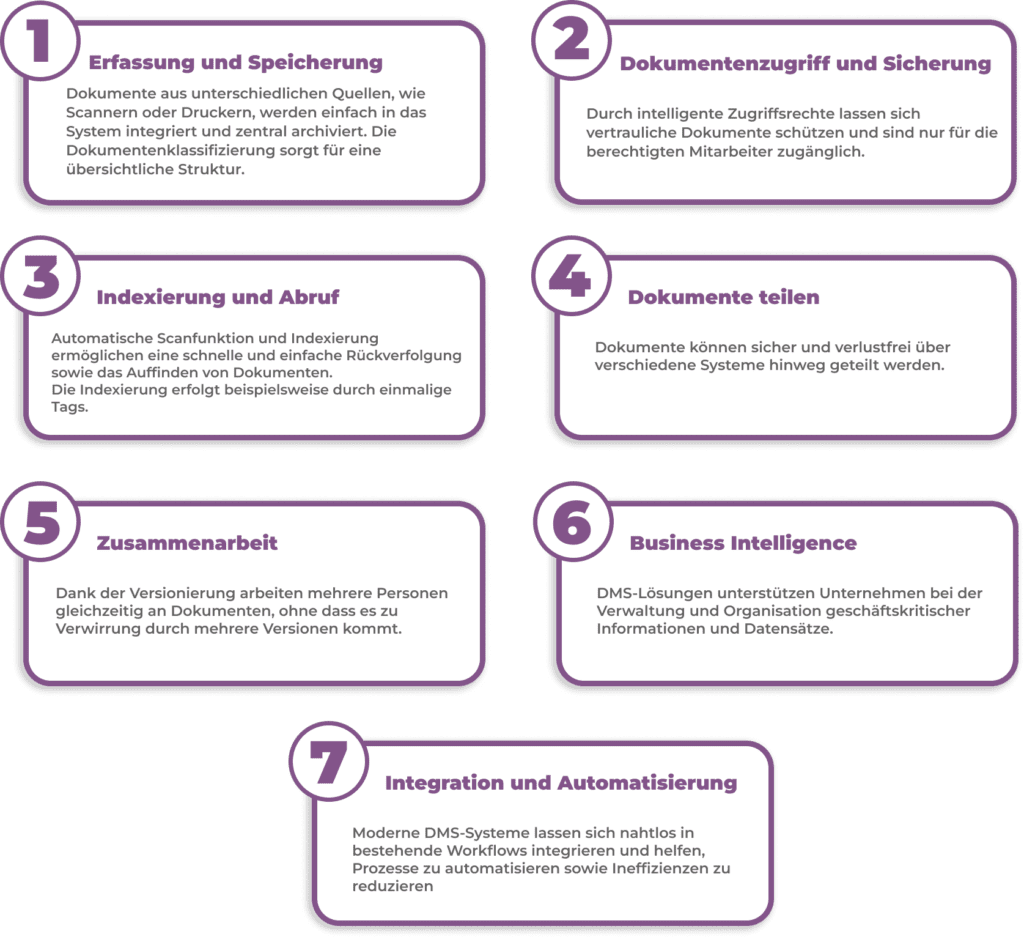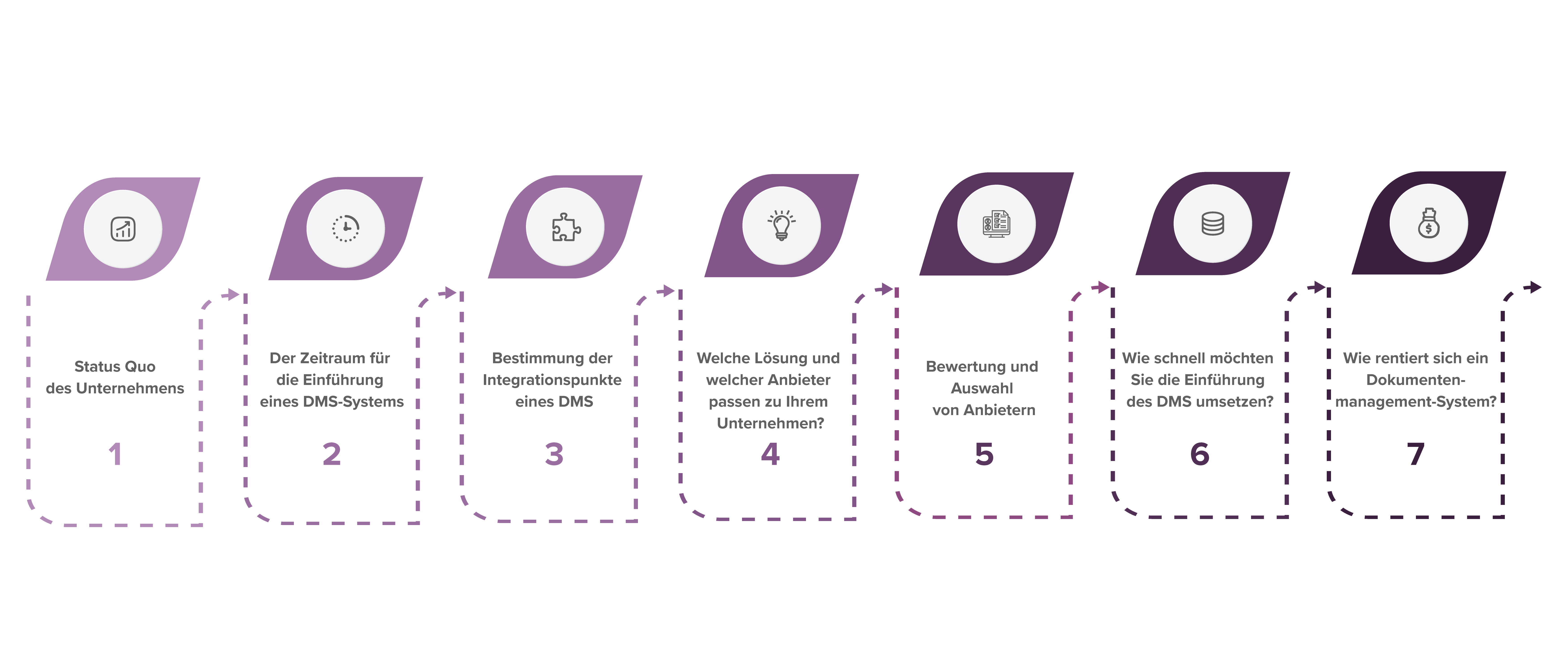Efficient digital document management for businesses
Digital document management system
A digital document management system (DMS) simplifies everyday work and provides effective support for managing digital documents. Companies in all industries process huge amounts of digital and paper-based documents every day. On average, each company uses around 10,000 sheets of paper per year. This results in impressive volumes of documents that need to be processed internally.
Optimal working practices are achieved when the capture, archiving, access, and management of documents are fast and efficient—without complicated workflows, time-consuming searches, or the risk of data loss. Dealing with paper documents and manual processes can quickly become inefficient and time-consuming, which has a negative impact on productivity. But there are solutions to significantly optimize these processes. Learn more about the tasks of document management and the benefits that a modern DMS solution can bring to your company. We are happy to assist you with the transition.
What is a digital document management system?
A document management system (DMS) enables paper documents and digital files to be stored centrally in a digital archive. By integrating a DMS, companies can efficiently capture, process, store, and track their documents. Clear objectives and careful planning are crucial for implementing the system quickly and effectively.
A DMS usually consists of several standard components that ensure smooth document management:

- Erfassung und Speicherung
Dokumente aus unterschiedlichen Quellen, wie Scannern oder Druckern, werden einfach in das System integriert und zentral archiviert. Die Dokumentenklassifizierung sorgt für eine übersichtliche Struktur. - Dokumentenzugriff und Sicherung
Durch intelligente Zugriffsrechte lassen sich vertrauliche Dokumente schützen und sind nur für die berechtigten Mitarbeiter zugänglich. - Indexierung und Abruf
Automatische Scanfunktion und Indexierung ermöglichen eine schnelle und einfache Rückverfolgung sowie das Auffinden von Dokumenten. Die Indexierung erfolgt beispielsweise durch einmalige Tags. - Dokumente teilen
Dokumente können sicher und verlustfrei über verschiedene Systeme hinweg geteilt werden. - Zusammenarbeit
Dank der Versionierung arbeiten mehrere Personen gleichzeitig an Dokumenten, ohne dass es zu Verwirrung durch mehrere Versionen kommt. - Business Intelligence
DMS-Lösungen unterstützen Unternehmen bei der Verwaltung und Organisation geschäftskritischer Informationen und Datensätze. - Integration und Automatisierung
Moderne DMS-Systeme lassen sich nahtlos in bestehende Workflows integrieren und helfen, Prozesse zu automatisieren sowie Ineffizienzen zu reduzieren.
What are the advantages of digital document management?
Even today, many offices are still dominated by mountains of paper and file folders, which costs time and money. A digital document management system (DMS) offers an efficient solution to overcome these challenges:
Less paper, more efficiency
A DMS saves time and money by simplifying document searches, reducing versioning, and digitizing paper-based processes. This leads to faster workflows and lower material costs.
Greater security and compliance
A DMS protects confidential data through controlled access rights and ensures comprehensive data security. Backups and contingency plans guarantee that documents are kept safe even in emergencies such as technical failures.
Easy Integration
Modern DMSs can be easily integrated into existing applications such as SAP, Microsoft Dynamics, and Outlook, enabling a seamless flow of information and the automation of important processes.
Increased productivity through automation
A DMS improves productivity by automating recurring tasks, such as forwarding documents or obtaining approvals. This makes workflows more efficient and reduces errors.
Flexible working from anywhere
A cloud-based DMS enables access to documents anytime, anywhere, whether in the home office or on the go. This allows your team to remain productive at all times, regardless of where they are working from.
Sustainability
DMS also supports sustainability, as it reduces paper consumption and digitizes processes. This not only saves money, but also makes a valuable contribution to environmental protection.
Improved Collaboration
Teams can access documents simultaneously and from different locations and edit them in parallel. This promotes collaboration and avoids confusion caused by different versions of a document.
Advanced search features
Thanks to the indexing and archiving of all documents, a DMS simplifies the search for and access to information, allowing you to find what you need quickly and accurately.
Versioning and audit compliance
A modern DMS ensures that all document changes are fully traceable. This allows you to restore previous versions and view the entire editing history of a document, which improves audit compliance.
Where can a digital document management system be used?
A document management system (DMS) can be used in many areas, especially in medium-sized companies. It supports the management of digital and electronic documents, promotes more efficient work, and automates routine tasks. Here are some key areas of application for a DMS:
In HR, a DMS simplifies many processes, such as hiring and managing employees. Important documents are automatically stored in a central archive, allowing HR managers to create straightforward workflows. Examples:
– Applicant management: Application documents are stored centrally and are easily accessible, which simplifies the selection process.
– Onboarding processes: Digital workflows enable welcome emails to be sent and facilitate the training of new employees.
A DMS can increase efficiency in financial processes, such as accounts receivable/accounts payable and financial auditing.
– Accounts payable: Invoices are recorded quickly and automatically, documents are assigned in a structured manner, and orders are reconciled.
– Accounts receivable: A DMS speeds up invoicing and payment tracking through linked documents.
– Financial auditing: A secure archive provides a complete record of all transactions for smooth audits.
It is often difficult to access important materials when on the go. A DMS can solve the following problems:
– Leads are captured via web forms and assigned to the responsible teams.
– Sales materials can be stored and shared digitally and securely.
Legal departments work daily with many sensitive documents and data. These must not only be stored securely and optimally organized, but also be easy to find and appropriately protected. DMS provide solutions for the typical requirements in legal departments by enabling security, efficiency, and clarity in document processes:
– Compliance and data protection: When handling sensitive documents, they must meet particularly high requirements for data security and legal compliance. A DMS offers advanced control options over confidential documents and ensures compliance with regulations such as ISO, HIPAA, and GDPR. It also simplifies the audit-proof storage of important documents.
– Efficient management and organization of documents: Despite digitalization, many legal departments still struggle with disorganized files, stacks of paper, and limited access to important documents. A DMS enables location-independent access to files and simplifies the storage, organization, and digital signing of documents. In addition, automated workflows accelerate approval processes and reduce errors that frequently occur in paper-based processes.
– Access security: Lawyers manage a wide range of sensitive documents such as contracts, case files, and personal data. Role-based access rights in a DMS ensure that only authorized persons can access confidential information. This significantly minimizes the risk of data leaks and unauthorized access.
– Seamless integration of existing systems: Legal departments often use various systems such as case management software or law firm management systems. A modern DMS can be easily integrated into existing systems, thus avoiding media disruptions and ensuring a smooth workflow.
Procurement plays a central role in the company and makes a significant contribution to business success. Efficient processes in procurement are crucial to minimizing costs and strengthening competitiveness. Smooth collaboration with suppliers and optimized order processing require effective organization of the relevant documents. By using a modern Document Management System (DMS) in procurement, companies can optimize their processes, increase productivity, and reduce costs.
– Supplier management: A DMS simplifies the central management of supplier contracts, quotations, and all communication with suppliers. All important documents are stored securely and clearly, so they can be quickly found using keywords or metadata. This ensures greater transparency and more efficient collaboration with suppliers.
– Optimized ordering processes: Through the automation and digitalization of procurement processes, order forms, quotations, and order confirmations are stored centrally and securely. This makes it possible to optimize order tracking, and important order documents are always accessible. In addition, a DMS helps to better monitor and comply with contract terms, as relevant documents can be linked together.
– Efficient invoice processing: A DMS enables the automatic capture, classification, and processing of incoming invoices. This allows invoices to be approved more quickly and efficiently, reducing the manual workload in procurement and significantly accelerating the entire invoice workflow.
7 steps to implementing digital document management

Cloud-based services are the key to future-proof and efficient digital document management. They offer the ability to flexibly and easily scale storage requirements without having to invest in expensive hardware. Thanks to flexible cost models, the cloud also provides a transparent and effective solution for storing digital data. In combination with a modern Document Management System (DMS), it forms the foundation for future-ready digital work. However, the introduction of digital document management requires thorough planning. To structure and successfully implement the process, you should follow these seven steps:
Step 1: Status quo of the company
Before starting the implementation of a DMS, it is important to analyze the current state of your company and the relevant departments. This allows you to determine requirements precisely and identify which systems are necessary for digital document management. Involve your employees and identify optimization potential, particularly in areas with high paper consumption. The benefits of a DMS are clear: it improves internal processes, saves storage costs, and helps ensure compliance with data protection regulations. Also determine the specific added value the DMS should bring to your company.
Step 2: The timeline for introducing a DMS
A DMS should not only meet current requirements but also be scalable in the long term. Even if you currently do not prefer a cloud solution, you should consider it, since data volumes in companies continue to increase. A flexible system that supports both in-house and cloud solutions provides maximum flexibility and helps you be prepared for future requirements.
Step 3: Determining the integration points of a DMS
Integration is one of the central functions of any Document Management System (DMS). Just as GastroHero GmbH identified its integration points to increase operational efficiency, you too can determine the relevant interfaces for your company by analyzing your workflows. Below are some examples of common integration points in three key business areas:
- Invoice approval: To seamlessly connect document flow with your financial data, integrating a DMS into an accounting or ERP system is essential. For smaller companies, systems like Lexware are suitable, while larger companies often rely on solutions like Microsoft Dynamics.
- Employee onboarding: HR departments often work with HR software such as Oracle HCM Cloud. A DMS supports this by automating processes to ensure that documents are captured, processed, and stored in compliance with data protection requirements.
- Contract management: In contract management, integration with Microsoft Word is often crucial. Integrating a DMS with Word enables documents to be embedded into structured workflows while providing version control – an important factor for the success of legal and procurement teams. By identifying and implementing these integration points, you can sustainably increase efficiency in your company.
Step 4: Which solution and provider fit your company?
Once you and your employees have defined clear goals for the Document Management System (DMS), it is time to contact a competent partner for implementation. With them, you define your “must-haves” and “nice-to-haves,” based on your specific requirements. The implementation partner will then develop a tailored solution that meaningfully supports your investment and leads to greater efficiency in workflows over the long term. At this stage, the provider should already offer concrete proposals to solve relevant problems – such as processing invoices or delivery notes – based on a suitable DMS. It is important that the provider fits your company. Check whether it is a young cloud startup or an experienced DMS manufacturer. Experience is a critical success factor for implementation and should be contributed by the provider. An experienced partner will give you a comprehensive overview of the DMS solution suitable for your company. Ideally, you will receive all necessary functions including support, service, and training from a single source, ensuring a seamless introduction.
Step 5: Evaluation and selection of providers
In the final step, you should find the right partner for your company, especially if it is a small or medium-sized enterprise (SME). Some proven approaches to finding DMS providers are:
- Analysis of reports by Gartner, Inc., Forrester Research, Inc., and AIIM
- Visiting review platforms such as G2 Crowd, Capterra, and Peer Insights
- Reading published case studies
Once you have compiled a list of potential providers, ask yourself the following six questions to narrow down the list:
- How complete is the cloud offering? Many providers claim to offer cloud services but are based on outdated technology. Make sure the provider offers a cloud-based system with features such as document management and workflow management that is accessible from any device.
- How user-friendly is the application? The acceptance and use of a DMS system strongly depends on user-friendliness. Choose an intuitive system that your employees can use without difficulty.
- Is the infrastructure globally available? The system should be available worldwide, fast, redundant, scalable, and high-performing. Avoid providers restricted to local data centers, as they often cannot offer the same advantages.
- Are security and data protection a priority? Your data must be securely stored to comply with regulations. Ensure the provider offers data separation and encryption and does not compromise on security.
- Is integration with other applications seamless? Seamless integration is crucial for efficiency. Avoid providers where integration is complicated or requires additional support, as this causes extra costs.
- Does the DMS provider have a good reputation? Choose a provider with a proven track record that demonstrates reliability in delivering on its promises.
Step 6: How quickly do you want to implement the DMS?
The timeframe for implementing a Document Management System depends on the industry, company size, and business objectives. Implementation can take place within 90 days or over several months. Together with your employees, determine how urgently the DMS is needed and what timeline is realistic – without putting unnecessary pressure on the company. It is important that the introduction of the DMS does not create additional workload for your company. Daily operations should continue as smoothly as possible. Therefore, seamless integration of the DMS into your existing working environment is crucial.
Step 7: How profitable is a Document Management System?
Switching to a digital DMS naturally involves investment costs. New technologies and the necessary specialists for implementation are associated with expenses. Don’t forget to also plan training for your employees – because only if they can use the system confidently will the DMS realize its full potential. To get the most out of your investment, it is advisable to carry out a follow-up analysis by the provider after about six to twelve weeks. An on-site visit gives employees valuable tips for their daily workflows and further increases productivity. Once all departments are using the DMS effectively, you will quickly see that lengthy manual processes are either automated or completely eliminated. Your company will work more efficiently, and the investment will pay off.
Does your company need a digital document management system?
Are you unsure whether a digital document management system (DMS) can optimize your internal processes and make your everyday work easier? With our self-test, you can analyze your current document management challenges and determine whether a DMS would be beneficial for you.
Answer the following questions honestly with “Yes” or “No”:
- Does it often happen that multiple versions of a document are in circulation and it is difficult to identify the most recent version?
- Do you have limited access to important documents and information when you are outside the office or on the road?
- Do you or your team spend too much time manually searching for specific documents?
- Do you find it challenging to control and manage access to files?
- Do you regularly work with sensitive information that must be stored and exchanged securely?
- Are you concerned about compliance with legal regulations, such as the GDPR, when processing and sharing documents?
- Do you need to exchange documents efficiently with external partners, customers, or service providers?
- Is your company losing track of approval processes, leading to delays?
- Would you have difficulty recovering your documents in the event of data loss or a natural disaster?
- Would you like to improve efficiency and information flow in your company?
- Are you frustrated by the disorder and lack of structure in document management?
- Is smooth collaboration in distributed teams or when working from home important for your company?
- Do you have high printing costs due to the need for physical documents?
- Do you regularly have to meet discount deadlines and need quick access to the relevant documents?
Successful with DocuWare:
With our professional consulting services and a DocuWare document management system, you can lay the foundation for your success in document management.
